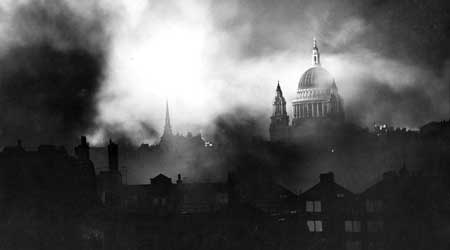Description
By an in-depth analysis of primary and secondary sources, students in this lesson will understand the basic facts behind the Blitz and how it affected the citizens of London, why Hitler decided to use the Luftwaffe against London and how a simple photograph served as a symbol around which the British people rallied during the dark early days of WWII.
Subjects
Art
English / Language Arts
European History
World History
World Geography
Grade Level
11-12Duration
90 minutesTour Links
- St. Paul’s Cathedral, London
Essential Questions
- What was the London Blitz of 1940-1941? How did the Blitz affect the citizens of London?
- How and why did the German government use the Blitz to bring “total war” to England?
- How and why did St. Paul’s Cathedral, one of London’s most iconic and important landmarks, become a symbol for the British people to rally around during the early dark days of WWII?
Key Terms
- Battle of Britain
- BBC – British Broadcasting Company
- Daily Mail – London Newspaper
- The London Blitz of 1940-41
- Luftwaffe
- Parliament
- Propaganda
- Royal Air Force
- St. Paul’s Cathedral
- Winston Churchill
Winston Churchill, Prime Minster of the United Kingdom for most of the Second World War and its aftermath, inspired many of his countrymen who were then in the darkest days of the war against Germany. In his speech before the House of Commons in June 1940 he uttered one of his most famous quotations…
… we shall defend our Island, whatever the cost may be, we shall fight on the beaches, we shall fight on the landing grounds, we shall fight in the fields and in the streets, we shall fight in the hills; we shall never surrender…
In doing so, Churchill set the tone for the entire population to follow, one of defiance and self-sacrifice in the face of what seemed like overwhelming odds. On 29 Dec 1940, as Luftwaffe’s bombs tore London apart, Herbert Mason, a staff photographer for the Daily Mail newspaper, snapped an iconic photo of St. Paul’s Cathedral regally standing tall against the smoke and flames of the war. For the remainder of the conflict, St. Paul’s was seen by the British public to be standing over London, somehow protecting not only the city and the nation, but perhaps also the entire empire as well.
By an in-depth analysis of primary and secondary sources, students in this lesson will understand the basic facts behind the Blitz and how it affected the citizens of London, why Hitler decided to use the Luftwaffe against London and how a simple photograph served as a symbol around which the British people rallied during the dark early days of WWII.

- Students will be able to identify, understand and explain the London Blitz and its effect on the British public in the dark early days of WWII.
- Students will be able to identify, understand and explain how and why the image of St. Paul’s Cathedral surviving the Blitz served to rally the British public in the dark early days of WWII.
To view resource web pages, download the lesson plan PDF above.
I. Anticipatory Set
- Writing / Question: How and why do governments use propaganda to influence their citizens, especially during war? (10 min)
- Handouts – images of London during the Blitz (5 min)
II. Body of Lesson
- Lecture / PPT – Battle of Britain and the Blitz (20 min)
- Audio Recording – excerpt from Churchill’s speech “We Shall Never Surrender” (5 min)
- Video – “London Can Take It” (10 min)
- Video – BBC: “St. Paul’s Cathedral and the Blitz” (10 min)
- Independent Activity: Students read the Daily Mail Website below (20 min)
III. Closure
- Group Activity – Socratic discussion on the use of images of St. Paul’s Cathedral in London to rally the British public during the Blitz (5 min)
- Assessment – Essay: How and why did St. Paul’s Cathedral become one of London’s most iconic and important landmarks and thus a symbol for the British people to rally around during the early dark days of WWII?
- Homework Assignment: Identify symbols of American national identity.
Extension
On tour: Imperial War Museum (London)
While on tour, students can visit the Imperial War Museum on Lambeth Road in London to see for themselves many exhibits on the Blitz and other events from both world wars. Highly recommended for anyone who wants to understand WWII from the British perspective. Admission is free.

